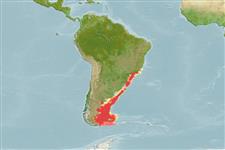Classificação / Names
Common names from other countries
Referência principal
Tamanho / Peso / Idade
Max length : 95.0 cm TL macho/indeterminado; (Ref. 1371); common length : 50.0 cm TL macho/indeterminado; (Ref. 1371); common length :60 cm TL (female)
Length at first maturity
Lm 31.9 range ? - ? cm
Ambiente
; marinhas bentopelágico; oceanódromo (Ref. 51243); intervalo de profundidade 50 - 800 m (Ref. 9715), usually 100 - 200 m (Ref. 1371)
Clima / Intervalo
Temperate; 4°C - 7°C (Ref. 1371), preferred 12°C (Ref. 107945); 20°S - 56°S, 69°W - 40°W (Ref. 58452)
Distribuição
Descrição breve
Espinhos dorsais (total): 1; Raios dorsais moles (total): 43-52; Espinhos anais 0; Raios anais moles: 36 - 41; Vértebras: 50 - 53. Gill rakers short and thick with blunt tips. Pectoral fins relatively short, not reaching level of anal fin origin. Color is silvery with golden luster on back, silvery white on belly (Ref. 1371).
Categoria na Lista Vermelha da IUCN (Ref. 115185)
Ameaça para o homem
Harmless
Utilização humana
Pescarias: altamente comercial
Ferramentas
Relatórios especiais
Descarregue XML
Fontes da internet
Estimates of some properties based on models
Phylogenetic diversity index
PD50 = 0.5000 many relatives (e.g. carps) 0.5 - 2.0 few relatives (e.g. lungfishes)
Nível Trófico
4.2 ±0.67 se; Based on food items.
Resiliência
Baixo, tempo mínimo de duplicação da população 4,5 - 14 anos (K=0.13-0.19; tm=6)
Vulnerabilidade
High vulnerability (58 of 100)
Categoria de preço
